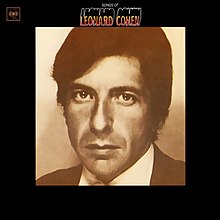Songs of Leonard Cohen
| Songs of Leonard Cohen | ||||
|---|---|---|---|---|
 |
||||
| Studio album by Leonard Cohen | ||||
| Released | December 27, 1967 | |||
| Recorded | October - November 1967 | |||
| Studio | Columbia Studio E, New York | |||
| Genre | Folk | |||
| Length | 41:09 | |||
| Label | Columbia | |||
| Producer | John Simon | |||
| Leonard Cohen chronology | ||||
|
||||
| Professional ratings | |
|---|---|
| Review scores | |
| Source | Rating |
| AllMusic | |
| Pitchfork | 9.6/10 |
| Q | |
| Rolling Stone | |
| The Rolling Stone Album Guide | |
| Uncut | |
Songs of Leonard Cohen is the debut album by Canadian folk singer-songwriter Leonard Cohen, released in December 1967 on Columbia Records. Less successful in the US than in Europe, Songs of Leonard Cohen foreshadowed the kind of chart success Cohen would go on to achieve. It reached number 83 on the Billboard 200 and achieving gold status in the US only in 1989, but peaked at number 13 on the UK Albums Chart, and spent nearly a year and a half on it.
Cohen had received critical acclaim as a poet and novelist but had maintained a keen interest in music, having played guitar in a country and western band called the Buckskin Boys as a teenager. In 1966, Cohen set out for Nashville, where he hoped to become a country songwriter, but instead got caught up in New York City's folk scene. In November 1966, Judy Collins recorded "Suzanne" for her album In My Life and Cohen soon came to the attention of famed record producer John Hammond. Although Hammond (who initially signed Cohen to his contract with Columbia Records) was supposed to produce the record, he became sick and was replaced by the producer John Simon.
Initially, Hammond had Cohen work up guitar parts for "Master Song" and "Sisters of Mercy" with jazz bassist Willie Ruff, and then brought in some of New York's top session musicians to join them, a move that made Cohen nervous; as biographer Anthony Reynolds observes in his book Leonard Cohen: A Remarkable Life, the dynamic between Cohen and Ruff had been intimate and natural but "the arrival of more anonymous personnel unnerved Cohen, the studio novice put off by their proficiency." Cohen did ask that a full-length mirror be brought into the studio because, as he explained to Mojo in November 2001, "through some version of narcissism, I always used to play in front of a mirror. I guess it was the best way to look while playing the guitar, or maybe it was just where the chair was. But I was very comfortable looking at myself playing." After Hammond dropped out of the sessions, John Simon took over as producer and, by all accounts, Simon and Cohen clashed over instrumentation and mixing; Cohen wanted the album to have a sparse sound, while Simon felt the songs could benefit from arrangements that included strings and horns. Writing for Mojo in 2012, Sylvie Simmons recalls, "When Leonard heard the result, he was not happy; the orchestration on 'Suzanne' was overblown, while everything about 'Hey, That's No Way to Say Goodbye' felt too soft. Several tracks had too much bottom, and there were even drums; Leonard had clearly stipulated no drums." The singer and producer also quarreled over a slight stop in the middle of "So Long, Marianne," - a device Cohen felt interrupted the song. According to biographer Ira Nadel, although Cohen was able to make changes to the mix, some of Simon's additions "couldn't be removed from the four-track master tape."
...
Wikipedia
